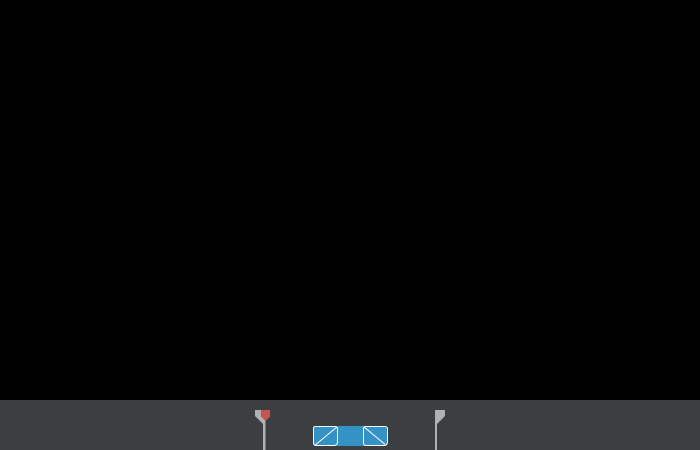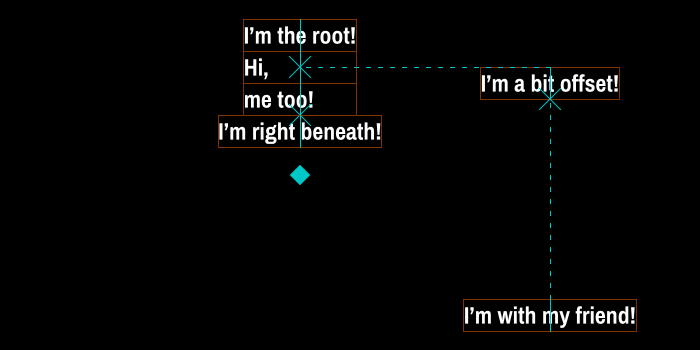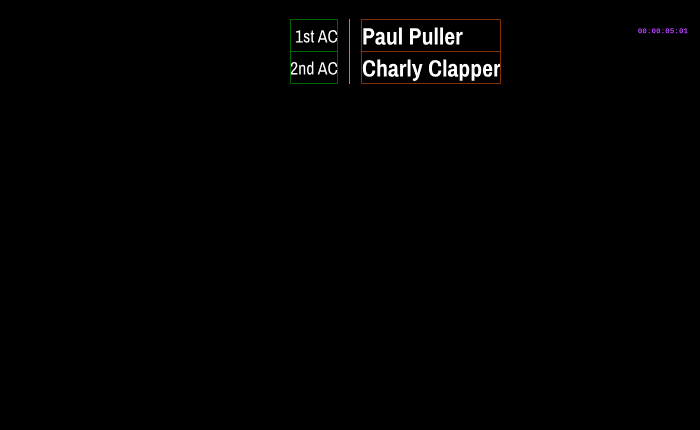3. Credits Spreadsheet
The Credits spreadsheet in the project folder houses your credits alongside some important metadata. It can host multiple credits sequences by having multiple worksheets (e.g., one for opening and one for closing credits).
The file may either be a local xlsx/xls/ods/csv file or an url/webloc shortcut that points to a Google Sheet.
To change the format, simply switch out the Credits file. For example, to change from a local to a cloud project, just upload your local Credits.xlsx/xls/ods/csv file to Google Sheets, put a shortcut named Credits.url/webloc to the Google Sheet into the project folder, and delete the old Credits file.
Towards the top of the spreadsheet, you’ll find the table header, which defines the following columns:
| @Head | @Body | @Tail | @Vertical Gap | @Content Style | @Break Match | @Spine Position | @Page Style | @Page Runtime | @Page Gap |
|---|---|---|---|---|---|---|---|---|---|
This article explains the meaning of each column, as well as all other aspects of the spreadsheet. For conciseness, the example tables omit columns that are irrelevant.
Head-Body-Tail Blocks
A person’s name often times doesn’t stand alone. Most likely, it’s accompanied by a role name, job title, or some other prefix or suffix. Sometimes, multiple people share the same job title (for example in a list of extras).
Cinecred models all this via so-called head-body-tail blocks. Such a block consists of an optional head text, an arbitrary number of body texts, and an optional tail text. Here are some example blocks as they would appear in the spreadsheet.
- A standalone actor block on a title card could have a single body cell with the actor’s name:
| @Head | @Body | @Tail |
|---|---|---|
| Alex |
- A single credit block could have the head “Gaffer” and a single body cell with the gaffer’s name:
| @Head | @Body | @Tail |
|---|---|---|
| Gaffer | Gustav |
- A drivers block could have the head “Drivers” and one body cell for each driver:
| @Head | @Body | @Tail |
|---|---|---|
| Drivers | Dominic | |
| Detlef | ||
| Dora |
- A song block could have the song title as its head and one body cell for each credit line:
| @Head | @Body | @Tail |
|---|---|---|
| Loremium Ipsumium | Written by Cicero | |
| Dedicated to Brutus | ||
| Pilfered by Some 60s Typesetter |
- An opening title block could have a single body cell with the director’s name and some enclosing words in the head and tail:
| @Head | @Body | @Tail |
|---|---|---|
| A | Dirc | Film |
Tags
Sometimes, it’d be nice to insert a blank body cell. Simply leaving an empty cell would however split the block in two. Instead, use the “{{Blank}}” tag:
| @Head | @Body | @Tail |
|---|---|---|
| Ada Amazing | ||
| {{Blank}} | ||
| Ben Baffling |

As you will learn later on, the look of text is governed by letter styles. To change the letter style of the head, body, or tail mid-text, use the “{{Style}}” tag. It either applies a specific letter style (“{{Style X}}”), or resets to the initial style (“{{Style}}”):
| @Head | @Body | @Tail |
|---|---|---|
| Copyright © 2023 {{Style Name}}Callie Cash{{Style}} and {{Style Name}}Molly Money |

Pictures
Instead of text, a body cell can also contain a picture from the project folder or any subfolder. For example, to insert Cinecred Large.svg, write:
| @Head | @Body | @Tail |
|---|---|---|
| {{Pic Cinecred Large.svg}} |

Be Cautious About Formats
For logos, always try to use files with the extensions svg/pdf/ai/eps/ps. These are vector graphics that can be scaled arbitrarily without any quality loss. If you don’t have a vector version of a logo at hand, ask for it. Only fall back to png/gif files if absolutely necessary, as these are raster graphics, which may look bad upon rescaling.
Do absolutely never use jpg/jpeg files for logos. While JPEG compression appears visually lossless for organic photos, it badly messes up high contrast edges, of which there are plenty in typical logos. The result will look very amateurish:


Resize and Crop
By default, pictures are shown in their original size. To resize them, append either “[width]x” or “x[height]”. For example, to make the picture 200 pixels wide, write:
| @Head | @Body | @Tail |
|---|---|---|
| {{Pic Cinecred Large.svg 200x}} |
You can crop the empty space around vector pictures (svg/pdf/ai/eps/ps) by appending “Crop”. For example:
| @Head | @Body | @Tail |
|---|---|---|
| {{Pic Cinecred Large.svg Crop}} |
Cropping can of course be combined with resizing.

Videos
Analogously to pictures, a body cell can also contain a video from the project folder or any subfolder. For example, to insert Blooper.mov, write:
| @Head | @Body | @Tail |
|---|---|---|
| {{Video Blooper.mov}} |
In the credits, the video will start playing as soon as it comes into view:

The still preview shows the video’s first frame in low resolution:

Image sequences are also supported. Suppose there’s the following sequence in the project folder:
- My Cinecred Project
- Vanity Card
- Vanity Card.0000001.dpx
- Vanity Card.0000002.dpx
- Vanity Card.0000003.dpx
- …
- Vanity Card.0000001.dpx
- Vanity Card
To include it, refer to the name of the sequence folder:
| @Head | @Body | @Tail |
|---|---|---|
| {{Video Vanity Card}} |
Resize
By default, videos are shown in their original size. To resize them, append either “[width]x” or “x[height]”. For example, to make the video 200 pixels wide, write:
| @Head | @Body | @Tail |
|---|---|---|
| {{Video Blooper.mov 200x}} |
Temporal Margin
Each video has an allotted timeframe in which it will play. By default, that timeframe starts as soon as the video comes into view and stops once it goes out of view:

To shrink the timeframe, append “Margin”, followed by a timecode specifying how much time should be peeled off the timeframe at the start and end. For example, to start the timeframe one second later and end it one second earlier, write:
| @Head | @Body | @Tail |
|---|---|---|
| {{Video Blooper.mov Margin 00:00:01:00}} |

To control the start and end margins separately, specify two timecodes:
| @Head | @Body | @Tail |
|---|---|---|
| {{Video Blooper.mov Margin 00:00:01:00 00:00:00:00}} |

Trim
By default, the video plays from its beginning and fully covers the allotted timeframe. You can trim the range that is played by appending “In” and/or “Out”, followed by a timecode (for video files) or frame number (for image sequences). The “Out” point is exclusive.
For example, to trim the first 2 seconds and 10 frames and only keep 2 seconds of a video file, or to only play frames 0000042 onward of an image sequence, write:
| @Head | @Body | @Tail |
|---|---|---|
| {{Video Blooper.mov In 00:00:02:10 Out 00:00:04:10}} | ||
| {{Video Vanity Card In 42}} |

Align
If the video’s length (after trimming) doesn’t exactly match the allotted timeframe, the video’s first frame is by default aligned with the timeframe’s beginning. Alternatively, you can append “Middle” or “End” to align the video’s middle respectively last frame with the timeframe’s middle respectively end:
| @Head | @Body | @Tail |
|---|---|---|
| {{Video Blooper.mov In 00:00:02:10 Out 00:00:04:10 Middle}} |

Fade
To have the video smoothly fade in and out, append “Fade”, followed by the fading duration(s) in the form of again one or two timecodes:
| @Head | @Body | @Tail |
|---|---|---|
| {{Video Blooper.mov Margin 00:00:01:00 Fade 00:00:00:12}} |

Of course, all the video options can be freely combined:
| @Head | @Body | @Tail |
|---|---|---|
| {{Video Blooper.mov x200 Margin 00:00:03:12 Fade 00:00:01:00 In 00:04:20:00 End}} |
Audio
Cinecred only processes video streams and discards any accompanying audio. If you want to retain the sound, you need to bring it back manually in finishing. To do this, export the Timeline of Embedded Videos as a CSV or EDL from the delivery window, and use it to precisely align the audio of each embedded video clip.
Vertical Gaps
You declare vertical gaps between blocks directly in the spreadsheet. An empty row automatically constitutes a vertical gap of 1 unit. Alternatively, you can manually enter a vertical gap in between two blocks, which overrides the automatic gaps:
| @Head | @Body | @Tail | @Vertical Gap |
|---|---|---|---|
| Crew | |||
| 1.5 | |||
| Sarah Supervisor |
A vertical gap of 1 unit corresponds to some amount of pixels. You can configure this amount in the project settings. We advise you to set it to your main font height, but other choices are also valid if they aid your design.

Sometimes it might be necessary to specify vertical gaps directly in pixels. This can be done by appending “px”:
| @Head | @Body | @Tail | @Vertical Gap |
|---|---|---|---|
| Crew | |||
| 10px | |||
| Sarah Supervisor |
Content Styles
Cinecred needs to know how you want each block to be rendered. For example, while a job-person-block usually has the head (job) to the left of the body (person), a song has the head (song title) above the body (song details). And if there are multiple body cells, should they be put in a grid or flown dynamically? Should the body be interpreted as paragraphs? Which fonts should be used? And so on…
All these aspects and lots more are defined by content styles, which you configure in the styling window. You then put the name of such a content style in the spreadsheet to assign it to all following blocks:
| @Head | @Body | @Tail | @Content Style |
|---|---|---|---|
| Crew | Heading | ||
| 1st Assistant Director | Sarah Supervisor | Gutter | |
| 2nd Assistant Director | Sandro Scheduler |

Spine Position
The spine is the vertical cyan line in the preview. Cinecred strings together blocks along it, one below the other. The spine is centered by default, but you can move it using the @Spine Position spreadsheet column.
On scroll pages, you move the spine left or right by specifying a horizontal pixel offset from the screen center:
| @Head | @Body | @Tail | @Spine Position |
|---|---|---|---|
| I’m a lefty! | -150 | ||
| Me too! | |||
| I’m a righty! | 150 | ||
| I’m dead center! | 0 |

On card pages, you can move the spine to any position by specifying a horizontal and optionally vertical pixel offset from the screen center. This position will be marked as a small cyan diamond. By default, the spine will be vertically centered around the position, but you can append “Below” or “Above” to put the spine below or above it:
| @Head | @Body | @Tail | @Spine Position |
|---|---|---|---|
| I’m a lefty! | -150 | ||
| I’m a top-righty! | 150 -50 | ||
| I’m below y’all! | 0 50 Below | ||
| Me too! |

On both scroll and card pages, you can have the spine run parallel to the previous one by specifying a horizontal offset from the center and appending “Parallel”:
| @Head | @Body | @Tail | @Spine Position |
|---|---|---|---|
| I’m a lefty! | -150 | ||
| Me too! | |||
| I’m a righty! | 150 Parallel |

In cases where a simple “Parallel” is too limited, you can also arbitrarily arrange the spine in relation to a previous one. To do this, write “Hook”, followed by how many spines we have to walk back to reach the spine that the new one will be attached to. Then specify which point in the other spine (“Top”, “Middle”, or “Bottom”) should be connected to which point in the new spine. For example, write “Bottom-Top” to glue the end of the other spine to the start of the new one. Optionally, append a horizontal and vertical pixel distance between the connected points:
| @Head | @Body | @Tail | @Spine Position |
|---|---|---|---|
| I’m the root! | -50 | ||
| Hi, | |||
| me too! | |||
| I’m right beneath! | Hook 1 Bottom-Top | ||
| I’m a bit offset! | Hook 2 Middle-Top 250 | ||
| I’m with my friend! | Hook 1 Bottom-Top 0 200 |

Notice that with both “Parallel” and “Hook”, the whole compound is positioned as one big unit, not just the root spine. For example, when you look at the cyan diamond in the image above, you see that the whole compound is vertically centered around the position (-50, 0).
Page Styles
Cinecred supports both title cards and rolling credits. The umbrella term for both is page. Your credits are simply composed of a sequence of pages. The behavior of each page (that is, whether it’s a card or a scroll, and details like the fade duration and scrolling speed) is defined by a page style, which you configure in the styling window. The default template ships with two aptly named page styles: “Card” and “Scroll”.
In the spreadsheet, you indicate the start of a new page by putting the name of a page style there:
| @Head | @Body | @Tail | @Page Style |
|---|---|---|---|
| A | Dirc Director | Film | Card |
| Executive Producers | Callie Cash | Card | |
| Molly Money | |||
| Cast | Scroll | ||
| (in order of appearance) |

Page Runtime
This column sets the runtime (including fades) of a particular page, overriding all styling settings. When used on a scroll page, it shrinks or grows the vertical gaps to tune the runtime, just like the project-wide Runtime Fine Adjustment or the per-style Runtime Fine Adjustment.
| @Head | @Body | @Tail | @Page Style | @Page Runtime |
|---|---|---|---|---|
| A | Dirc Director | Film | Card | |
| Producer | Callie Cash | Card | 00:00:05:00 | |
| Tom | Johnny McRonny | Scroll | ||
| John | Ronny von Tommy | |||
| Gaffer | Gustav Gluehbirne | Scroll | 00:01:23:00 | |
| Key Grip | Detlef “Dolly” Driver |
You may also jointly tune any group of scroll pages. To do this, specify the runtime only for the group’s first page, but prepend a group name that you then reference from the group’s other pages. Notice that card pages cannot be included in a group.
| @Head | @Body | @Tail | @Page Style | @Page Runtime |
|---|---|---|---|---|
| A | Dirc Director | Film | Card | |
| Tom | Johnny McRonny | Scroll | Blub 00:02:42:20 | |
| John | Ronny von Tommy | |||
| Gaffer | Gustav Gluehbirne | Scroll | Blub | |
| Key Grip | Detlef “Dolly” Driver |
Page Gap
If you put a timecode into this column between two pages, the credits will show a blank screen between them for that amount of time, overriding the Subsequent Page Gap page style setting. Negative durations are also admissible and cause the next page to commence while the previous page is still running. For example, you could let a copyright title card fade in while the credits are still rolling out of frame.
Alternatively, you can put “Melt” here to absorb the two pages into a bigger page. For example, say that a scroll page is melted with a following card page. The scroll first commences as usual, but then at its end actually includes the card and stops on it; the card then takes over and finally fades out after its display duration has passed. You could use this feature to, for example, stop the credits roll on a final copyright notice, which then gracefully fades out.
There is no limit to the type and number of pages you can melt together. For example, you could have an elaborate sequence of cards and scrolls all melt into a single page, which then looks like a single scroll that pauses multiple times.
| @Head | @Body | @Tail | @Page Style | @Page Gap |
|---|---|---|---|---|
| A | Dirc Director | Film | Card | |
| 00:00:04:00 | ||||
| 1st AC | Paul Puller | Scroll | ||
| 2nd AC | Charly Clapper | |||
| Melt | ||||
| Copyright © 2023 | Card |

Break Match (Advanced)
To understand this column, you need to be familiar with the family of match settings found in content styles; namely Match Column Widths and Match Row Height for grid layouts, Match Cell Width/Height for flow layouts, and finally Match Head/Tail Width for heads and tails. As you know, these settings harmonize blocks all throughout the credits in various ways.
Now, what if you want the harmonization to not reach beyond a certain point? Say you’ve got two sections of gutter blocks on your page. While you’d like all head and body cells within either section to have the same width, this harmonization should not happen between the two sections. Well, simply put a space-separated list of “Head”, “Body”, or “Tail” into the @Break Match column:
| @Head | @Body | @Tail | @Break Match |
|---|---|---|---|
| Director of Photography | Peter Panner | ||
| 1st AC | Paul Puller | ||
| 2nd AC | Charly Clapper | ||
| Head Body | |||
| Gaffer | Gustav Gluehbirne | ||
| Key Grip | Detlef “Dolly” Driver | ||
| Best Boy | Francesco Foreman |
